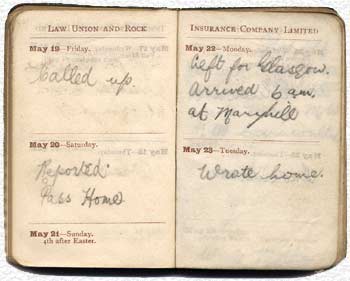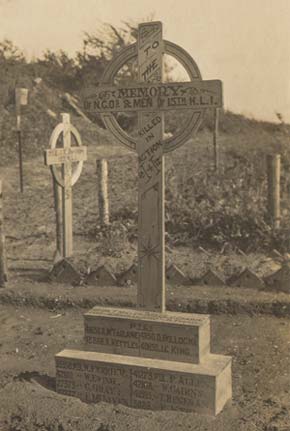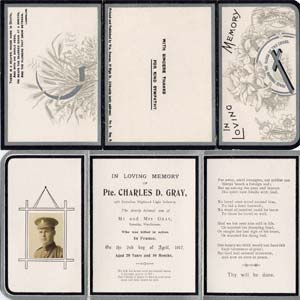|
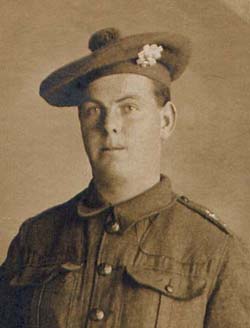
Pte Charles
Gray, 15th Highland Light Infantry
Charles
Duncan Gray was born at Sunside, Wardhouse in the Parish of
Kennethmont on 30th June 1896, the youngest son of James and
Ellen Gray. He had five elder brothers and two younger sisters
and was known to his family and friends as Charlie. His father
was tenant in the farm of Sunside on the Wardhouse Estate.
He had worked for and later took over the tenancy of Sunside
from his aunt Margaret Howie in the late 1890's. The Howie
family had farmed Sunside since before 1841.
Between
the outbreak of WW1 in August 1914 and May 1916 is is known
that Charlie was initially in the Royal Field Artillery, number
143793 and enlisted in Aberdeen. A photo of him in Regular
Army R.F.A. uniform is below. For some reason, possibly relating
to his age or health, he must have been discharged and returned
to civilian life and in 1916 he was employed in the office of Mr Duguid, Advocate, Union St, Aberdeen.
May
1916 saw universal conscription come into effect with a Military
Service Act applying to all men regardless of marital status
between 18 and 41 years. According to his diary Charles received
his call up papers on Friday May 19th, reported next day and
was then given a weekend pass home to Kennethmont. He left
for Glasgow in the early hours of Monday and reported to Maryhill
Barracks, the regimental headquarters of the Highland Light
Infantry (H.L.I.), at 6am and joined
"C" Company, 15th
(Service) Battalion (1st Glasgow) HLI.
|
|
|
15th
H.L.I. was known as the Glasgow Tramways Battalion. When the
battalion was raised by the Lord Provost and City of Glasgow
on 2nd September 1914 the vast majority it's volunteers came
from the Glasgow Tramways. They arrived in France in November
1915. He began his basic training at Maryhill
and was then transferred to Montrose on 20th June having received
his inoculations, etc. He was paid 8/- (40p) a week and billeted at Union Mills. On 22nd
July he was home for a weekend and started musketry training
on 14th August.
|
As the move
to the Front became imminent he was home for the last time on five
days embarkation leave commencing 1st September 1916. His battalion
moved to Folkestone on the 27th arriving there at 6am next morning.
By four in the afternoon they were in France and moved from the port
of Boulougne to Base Camp at Etaples next day. After further training
at Etaples they finally went into the line in the Arras sector on
October 10th at Busnes, near Bethune.
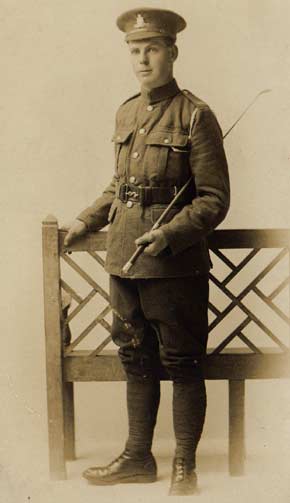
Gunner
Charles Gray, R.F.A.
|
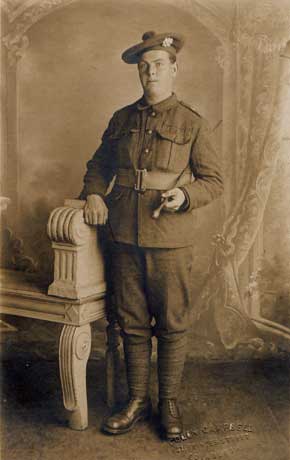
Pte
Charles Gray, 15th H.L.I.
|
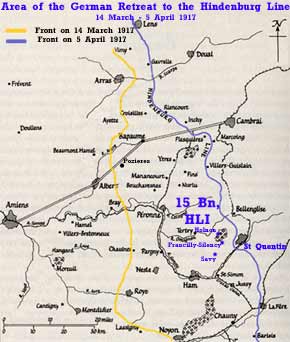
Click
on image to view large map.
|
15th
H.L.I. were involved in the actions during the German retreat
to the Hindenburg Line (14 Mar-5 Apr 1917). The German defences
of the Hindenburg Line ran from a position east of Arras to
near St Quentin on the British sector. The Germans withdrew
to these defensive positions.
The
Hindenburg Line, or Siegfried Stellung as they called it,
was a vast system of defences in Northern France constructed
by the Germans during the winter of 1916-17. It ran from the
area around Arras all the way to beyond St Quentin, and consisted
of deep and wide trenches, thick belts of barbed wire, concrete
machine-gun positions, concrete bunkers, tunnels and command
posts. It was considered virtually impregnable by the Germans.
The British offensives of late 1917 and 1918 were to prove
otherwise.
|
On
the day of his death on April 2 Charlie, in "C"
Company, 15th
H.L.I, with the 14th Brigade, arrived in the Bois-de-Savy
(Savy Wood) on the East of Saint Quentin about 3 on the morning
to take up attack positions. The objectives were Holnon and
Francilly-Selency, still nearer to St. Quentin on the oblique
line of the drive north-east across the town's western approaches.
The 1st Dorsets on the left had to seize Holnon. The 2nd Manchesters
had to go direct at Francilly, "B" Company of the
15th H.L.I. in support, with orders to consolidate the eastern
edge of Francilly. Two other companies of the 15th on the
right, "C" and "D" Companies, were to
capture the height which runs roughly east from the village.
This high ground was to have been taken by the 96th Brigade
which had failed. Two platoons of "A" Company were
employed as R.E. working parties and a third platoon as Battalion
reserve.
At
4.55 a.m. the British artillery laid down a heavy barrage
on the village which lasted five minutes. Then the 14th Brigade
attacked. The stormers were violently assailed by machine
gun fire along the entire front but they swept on purposefully
and laid hold of the allotted positions, taking numerous prisoners.
"D" Company of the H.L.I. captured three machine
guns in a quarry. The 2nd Manchesters were fired at point
blank by a battery of six German field guns situated on a
slope some hundred yards to the east of Francilly which was
in the hands of that Midland battalion.
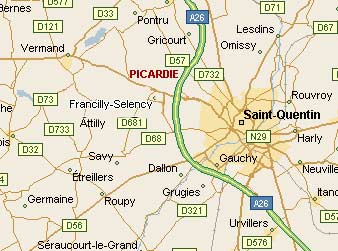
The
gunners decamped, however, under the fusilade of rifle and
machine gun fire, abandoning their pieces, whereupon the Manchesters
dug their line so as to command the battery position. The
15th H.L.I. had few casualties in the actual assault, but
about 6.15 a.m. the Germans opened a severe bombardment, smashing
shells into Francilly and battering the heights. On this wet
and dreary morning "B" and "C" Companies
were frenziedly digging to consolidate. The shelling went
on all day but did not turn the companies from the construction
of very fine trenches. They dug and dug with shell-bursts
all around them, dug for dear life. But they suffered 40 casualties
before they had prepared a position in which to resist counter-attack.
15
HLI Diary entry.
April 2. Bois-de-Savy. Attack and capture of Francilly.
Casualties for April : Officers, 2 killed, 3 wounded; other
ranks, 42 killed, 124 wounded.
It
is not known whether Charlie was killed during the attack
on the ridge at Francilly or during the later shelling of
their trenches. He and seventeen of his comrades who died
that day were buried in a grave near the railway line beside
the Holnon - Savy road in the battlefield cemetery that was
to become known as Savy Wood North Cemetery. It's 44 burials
were subsequently all moved to Savy
British Cemetery in 1920.
|
|
|
To
the
Memory
of
NCO's & Men of 15th HLI.
Killed in Action.
2/4/17
1395 Cpl T Miller
13539 Cpl G Bertram |
|
13753
L/Cpl C Crabb
42062
L/Cpl D Third
|
|
Ptes
40656 R McFarlane
13866 R Kettles
33338 W Ferrier
42801 W Ewing
27393 C Gray
42277 F McNiven
|
|
Ptes
41150 D Pollock
40650 J C King
41273 P Allen
42168 W Cairns
40595 T Henegan
3089 F Kerr
|
|
The original
grave and marker by the Holnon - Savy Road with the railway embankment
to the left. The photo was supplied to his father by The Graves Registration
Service in late 1917.
The Next of
Kin Memorial Plaque and Scroll
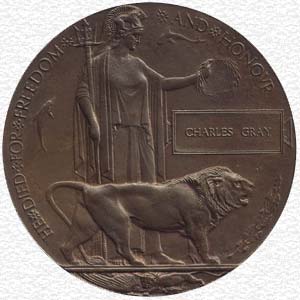
The Memorial
Plaque
This circular
bronze plaque, 4.75 inches (120mm) in diameter, was first issued in
1919 to the next of kin of those British and Commonwealth servicemen
and women who lost their lives on active service during the Great
War. Each one was different in that the commemorated individuals name
was embossed in raised letters within a tablet.
The design
shows Britannia bestowing a laurel wreath on the rectangular tablet.
A lion stands in the foreground, with dolphins above and an oak branch
in the lower right. A lion cub clutching a fallen eagle in its jaws
decorates the exergue. The wording around the circumference states:
HE (or SHE) DIED FOR FREEDOM AND HONOUR.
The final
total manufactured is estimated to be in the vicinity of 1,150,000
units, and represented the most universally distributed numismatic
work ever cast or struck, excluding money.
Due to some
similarity with the old one pence coin it was commonly known as a
Dead Man's or Death Penny.
The Memorial Scroll
and King's letter.
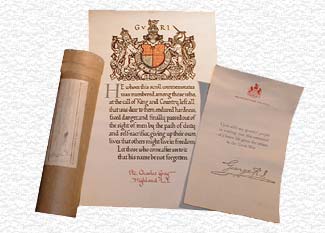
Next
of Kin Memorial Scroll
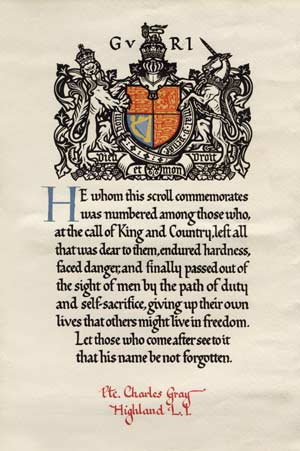
The
Scroll measures 180 mm by 280 mm and was printed from hand-cut
wood blocks, the design and production supervised by the London
County Council School of Arts. Printing of the scrolls started
in January 1919. The scroll was sent out in a cardboard tube,
accompanied by a letter from King George V.
|
King
George V letter
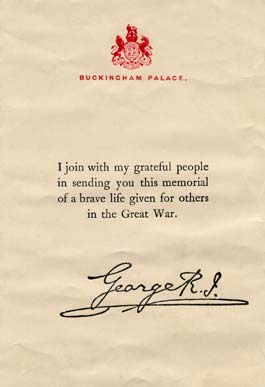
The
printed covering letter bearing a facsimile of the King's
signature.
The
memorial plaque and scroll, sometimes embellished by the deceased
soldier's war medals, were proudly displayed in hundreds of
thousands of homes after the First World War. This represented
a link with the Fallen, many of whom had no known grave in
the country where they fell.
|
|
|
It
was the practice of the time to commemorate a death on a Memorial
or Death Card. The card on the left is tri-fold and double
sided ( both sides shown). It bears a picture of Charles,
details of his death and a verse.
They would have been given to family members and friends.
Click
on the card it to view a full size image.
|
Charles
Gray was awarded these medals for serving his King and Country
in The Great War.
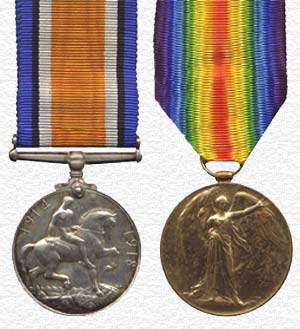
Move
mouse over medals to view reverse
The
British War Medal (left and Victory Medal (right) were awarded
to all personnel.
|
The British War Medal 1914-1918
The medal takes the form of a solid silver medal with an image
of a mounted figure of St George trampling the shield of the
central powers with the dates 1914 and 1918 thereon. At the
base is a skull and crossbones, symbolic of death, whilst
above is the rising sun of victory. The reverse has the coinage
head of George V.
Victory
Medal 1914 - 1919
It was decided amongst the Allies that a common theme would
be adopted and that each country would produce a medal to
commemorate the Victory. This medal took various forms according
to the country but a common item was the rainbow coloured
ribbon. The British medal shows the winged victory on the
front holding a palm branch in her right hand with the left
outstretched. The reverse has the words "The Great War
for Civilisation" surrounded by a laurel wreath.
The pair were affectionately known as "Mutt and Jeff".
|
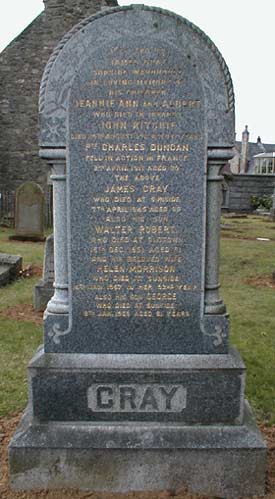
Gray
family headstone at Insch Kirkyard
|
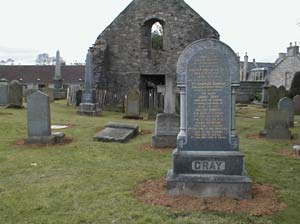
The
ruins of the original Insch Kirk with the
Gray family grave in the foreground.
The
family headstone at Insch Kirkyard has details of Charles.
GRAY
~~~~~~~
Pte
Charles Duncan
Fell in action in France
2nd April 1917 aged 20
~~~~~~~
Photographed
March 2002
|

James and Ellen Gray, Sunside.
|

